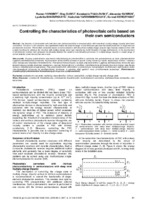| dc.contributor.author | Vorobey, R. I. | en |
| dc.contributor.author | Gusev, O. K. | en |
| dc.contributor.author | Tyavlovsky, K. L. | en |
| dc.contributor.author | Svistun, A. I. | en |
| dc.contributor.author | Shadurskaya, L. I. | en |
| dc.contributor.author | Yarzhembitskaya, N. V. | en |
| dc.contributor.author | Kierczynski, K. | en |
| dc.coverage.spatial | Польша | ru |
| dc.date.accessioned | 2022-07-13T09:32:30Z | |
| dc.date.available | 2022-07-13T09:32:30Z | |
| dc.date.issued | 2015 | |
| dc.identifier.citation | Controlling the characteristics of photovoltaic cells based on their own semiconductors / R. I. Vorobey [et al.] // Przeglad Elektrotechniczny. – 2015. – Vol. 91, № 8. – P. 81-85. | en |
| dc.identifier.uri | https://rep.bntu.by/handle/data/114048 | |
| dc.description.abstract | The features of photovoltaic cells with their own photoconductivity in semiconductors with deep-level multiply-charge impurity have been
considered. The use of such structures can significantly extend the dynamic range of sensitivity and gain new functional properties of single-element photoelectric receivers. Photovoltaic converters based on semiconductors with deep-level multiply-charge acceptor type impurity enable devices with a wider functionality, whereas the structure with multiply-charge donor type impurity has better linearity of energy performance. In the development of photoelectric receiver with advanced functionality features the model of recombination processes in multiply-charge impurity in a wide range of optical radiation power density has been used. | en |
| dc.language.iso | en | en |
| dc.publisher | Wydawnictwo SIGMA | en |
| dc.title | Controlling the characteristics of photovoltaic cells based on their own semiconductors | en |
| dc.type | Article | en |

